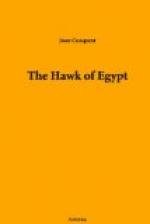He had all a Mohammedan’s belief in the hand of destiny, but the English blood in his veins filled him with horror at the thought of being torn to pieces by vultures after death; his desert blood filled him with an equal horror at the thought of being weighted down by the regulation tomb of bricks and mortar.
And so it came to pass on this night of the full moon, when the girl he loved was racing towards him and Fate was disentangling the threads she had knotted so grievously, that he lay stretched upon the block of wood which stood three feet high in the centre of this tent. He lay face downwards, with chin in hand, looking out through the lifted flap in the direction of Mecca, whilst the moon hung as a silver shield above him, and the desert enfolded him on every side.
Outwardly the tent was as that of any Bedouin; tan and brown, the colour of the camel’s hide, of which it was made; square-roofed, with one side only which lifted, the side which was towards Mecca.
Inside it was lined with a copy of the queen’s funeral canopy of softest leather; stretched square; to the touch as soft, supple and fine as velvet.[1]
True, this copy had not taken year upon year to make, nor had scores and scores of nimble fingers stitched and stitched for days and months to finish it, as in the days of the XIXth dynasty. The panels in the copy were of one piece of hide stitched finely by machinery, with the emblems painted upon them after the stitching; in the original they are made by the stitching together by hand of thousands and thousands of pieces of gazelle-hide, each of which had been painted either pink or blue or green or in various shades of yellow before the stitching.
Look up with Hugh Carden Ali as he lifts his head to gaze at something far beyond the tent-roof.
You will see a copy of the central square which, divided into two, rested upon the top of the shrine which covered the dead queen who died about one hundred years after the siege of Troy. One side of the panel is sprinkled with yellow and pink rosettes on a pale-blue ground; the other side shows the vulture, the emblem of maternity, holding in its claws the feather of justice; six there are in all.
That is the ceiling.
The tent walls are lined with a copy of the flaps which hung down on each side of the shrine of the funeral-boat of the Egyptian queen who, some thousand years before Christ, crossed the blue-green Nile, followed by other boats filled with her priests and princes, her officers, her mourning women. North and south, the flaps are of chess-board pattern in squares of pink and green; behind one of which was hidden the small room which held naught but a crystal pitcher and crystal basin, filled to the brim with water for the ablutions at the Hour of Nazam, which is the Hour of Prayer.
Near the top the sides show bands of colour, red, yellow, green and blue, almost as bright in the original as on the day the paints were mixed, one thousand years ago. Beneath the bands upon one side you will see the signet-ring of the priest-King Pinotem—whose son Queen Isi em Kheb espoused—; also the royal asps and the scarab, the emblem of life out of death.




